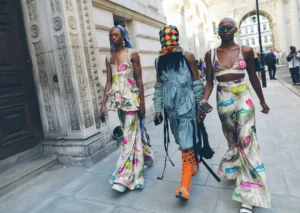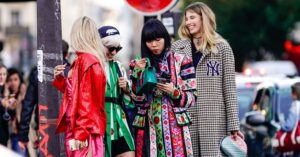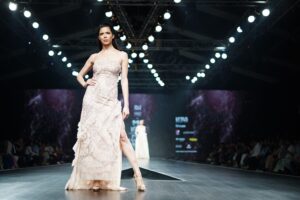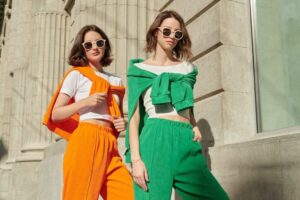Hey there, picture this: It’s a crisp autumn morning in 2018, and I’m standing in a tiny Manhattan studio apartment, surrounded by swatches of silk and denim scraps that look like they’d survived a tornado. My sewing machine is humming away, stitching what I hoped would be my first “signature” skirt—a quirky A-line number inspired by my grandma’s vintage aprons. Spoiler: It turned out lopsided, but that messy prototype sparked a love affair with fashion that’s still going strong seven years later. If you’re here because you’ve got that itch—the one where flipping through a magazine or scrolling Instagram makes you want to grab a pencil and sketch something wild—this article is for you. We’ll dive into the vibrant world of fashion, unpack the creative whirlwind of the design process, and map out real-talk career paths that could take you from intern to influencer (or at least pay the rent). No fluff, just the good stuff to get you dreaming big and planning smart.
Fashion isn’t just about clothes; it’s the stories we wear, the moods we stitch into seams, and the quiet revolutions happening in sustainable fabrics right now. As someone who’s juggled freelance gigs and full-time roles in New York and LA, I can tell you it’s equal parts thrill and hustle. Ready to explore? Let’s start at the beginning.
What Is Fashion Design?
Fashion design is the art and science of turning ideas into wearable magic—think everything from a cozy oversized sweater that hugs like an old friend to a bold statement coat that turns heads at a coffee shop. At its core, it’s about blending creativity with functionality, drawing from culture, trends, and personal flair to craft pieces that people actually want to slip into.
What draws me back every time is that spark of problem-solving: How do you make a dress flow just right without restricting movement? It’s like being an architect for the body, and in a world obsessed with fast trends, good design feels timeless, almost rebellious.
From haute couture gowns on Paris runways to everyday athleisure, fashion design shapes how we express ourselves daily. It’s evolved with tech like 3D printing and AI sketches, but the heart remains human—your vision on someone’s skin.
The Evolution of Fashion: A Quick History Lesson
Fashion has always mirrored society’s pulse, from the opulent ruffles of Versailles ballgowns signaling wealth in the 1700s to the punk zips of the ’70s rebelling against conformity. Fast-forward to today, and we’re in an era where sustainability isn’t a buzzword—it’s a mandate, with brands like Stella McCartney leading the charge on eco-chic.
I remember my first thrift flip in college: Turning a ratty ’90s flannel into a cropped jacket. It wasn’t revolutionary, but it taught me fashion’s roots in reuse and reinvention, lessons that echo in modern movements like upcycling.
This evolution isn’t linear; it’s a remix. Ancient Egyptian linens influenced minimalist Scandinavian lines, and now global fusion styles blend kimono sleeves with streetwear hoodies. Understanding this history? It’s your secret weapon for designing pieces that resonate across generations.
Key Milestones in Fashion History
- 1920s Flapper Era: Loose silhouettes and dropped waists liberated women post-WWI, sparking the ready-to-wear boom.
- 1960s Mod Revolution: Mary Quant’s miniskirts democratized style, making fashion youth-driven and accessible.
- 1990s Grunge Wave: Think Kurt Cobain’s plaid—raw, anti-glamour vibes that birthed sustainable casual wear.
These moments remind us: Fashion isn’t static; it’s a conversation. Dive deeper with this timeline from Vogue for visuals that pop.
The Fashion Design Process: Step by Step
The design process is like cooking a gourmet meal—you start with inspiration, layer in technique, and taste-test until it’s just right. It’s iterative, messy, and profoundly satisfying, often spanning six months from mood board to market-ready sample.
In my early days, I’d spend hours mood boarding on Pinterest, only to scrap it all for a late-night epiphany. That chaos? It’s where the best ideas hide. Today, with tools like CLO 3D, it’s faster, but the soul stays analog.
Whether you’re solo sketching or leading a team at Nike, this roadmap turns vague vibes into tangible threads. Let’s break it down.
Step 1: Research and Inspiration
This is the scavenger hunt phase—poring over trend reports from WGSN, street-styling in Tokyo via Instagram, or flipping through art books for color cues. It’s about soaking up culture, from music festivals to museum exhibits, to fuel your collection’s theme.
I once drew from a rainy hike in the Pacific Northwest for a waterproof jacket line; the earthy tones and rugged seams sold out in weeks. Skip this, and your designs feel flat—research keeps them fresh and fearless.
Aim for diversity: Mix high fashion with everyday heroes. Tools like Pinterest’s visual search make it effortless.
Step 2: Sketching and Conceptualizing
Grab a pencil (or stylus) and let ideas flow—rough croquis of silhouettes, fabric drapes, and quirky details. Here, quantity trumps perfection; aim for 20 thumbnails to whittle down to five winners.
My breakthrough? Doodling on napkins during boring meetings. Those scribbles became my portfolio’s star piece. Digital fans, Adobe Illustrator shines for vector precision.
Focus on the “why”: Does this evoke joy? Solve a pain point? It’s your emotional hook.
Step 3: Material Selection and Mood Boarding
Swatch shopping time—feel the heft of organic cotton versus the sheen of recycled polyester. Build a mood board with photos, palettes, and fabric clippings to visualize cohesion.
Humor alert: I once mistook faux fur for velvet; the sample itched like a bad date. Lesson learned: Touch everything. Sites like Fabric.com are gold for virtual sampling.
This step bridges dream to reality, ensuring sustainability (hello, low-water denim) without sacrificing style.
Step 4: Pattern Making and Prototyping
Translate sketches into flat patterns using software like Gerber or good old muslin draping. Cut, sew, fit on a mannequin—adjust for ease and flow.
My first prototype disaster: A sleeve that ballooned like a parachute. Trial and error built my eye. For pros, Browzwear’s 3D avatars cut waste.
Iterate ruthlessly; one fit session can save thousands in production tweaks.
Step 5: Production and Finalization
Scale up: Source factories, spec tech packs, and run samples. Test for durability—will it survive a wash cycle or a wild dance floor?
Emotionally, this is launch anxiety central, but seeing your vision sewn up? Pure adrenaline. Ethical tip: Vet suppliers via Fair Trade Certified.
From here, it’s market testing and tweaks—voilà, your design lives.
Essential Tools for Aspiring Fashion Designers
Tools aren’t just gadgets; they’re extensions of your hands, turning “what if” into “wow.” In 2025, the mix of analog and digital lets solos compete with studios, but picking the right ones saves sanity.
I started with a $20 sketchpad and graduated to CLO 3D after a freelance flop—now, I prototype virtually, slashing costs by 40%. The key? Match tools to your workflow, whether hand-stitching heirlooms or cranking out streetwear.
From free apps to pro suites, here’s your starter kit. Pro tip: Many offer trials; test-drive before committing.
Best Digital Tools for Sketching and 3D Modeling
| Tool | Key Features | Best For | Price (2025) |
|---|---|---|---|
| Adobe Illustrator | Vector sketches, tech flats, seamless integration with Photoshop | 2D technical drawings | $22.99/month |
| CLO 3D | Realistic fabric simulation, virtual fitting | 3D prototyping, reducing physical samples | $50/month (starter) |
| Marvelous Designer | Dynamic cloth physics, animation-ready exports | Haute couture draping | $79/month |
| Browzwear | Collaborative 3D design, PLM integration | Team-based production | Custom enterprise |
| TUKAcad | Pattern drafting, grading automation | Pattern makers on a budget | $1,500 one-time |
These cut prototyping time in half—check CLO’s tutorials here for a quick win.
Analog Must-Haves for Hands-On Creators
- French Curve Ruler Set: Essential for smooth necklines and hems—mine’s taped together from overuse.
- Tailor’s Chalk and Seam Ripper: Mark and unmake without mercy; the ripper’s your best friend during fits.
- High-Quality Fabric Scissors: Invest once ($30+); dull blades ruin edges and your mood.
Blend them: Sketch digitally, sew physically. It’s the hybrid magic of modern design.
Career Opportunities in Fashion Design
The fashion world’s a buffet—design for celebs, curate for retailers, or launch your indie label. Opportunities exploded post-pandemic, with e-comm and sustainability creating niches like ethical activewear devs.
My path zigzagged: From assisting at a Brooklyn startup (hello, 3 a.m. fittings) to heading juniorswear at a mid-tier brand. Salaries start modest but climb with hustle—median around $77K, per BLS. The thrill? Seeing your work in the wild.
Diversity reigns: Freelance for flexibility, corporate for stability. Global shifts mean roles in Asia’s factories or Europe’s luxe houses. Entry? Internships via CFDA’s network.
Pros and Cons of a Fashion Design Career
Pros:
- Creative Freedom: Channel your inner artist daily—no two collections alike.
- Global Impact: Influence trends worn by millions; travel to Milan or Mumbai for inspo.
- Varied Paths: Pivot from design to styling or buying without starting over.
- Networking Perks: Rub elbows with influencers at NYFW—my best collab came from a chance chat.
Cons:
- Irregular Hours: Deadlines mean weekends; burnout’s real if you don’t set boundaries.
- Competitive Waters: 30K U.S. jobs, growing 3%—portfolio’s your ticket.
- Income Volatility: Freelancers feast or famine; build savings early.
- Trend Pressure: Chasing “next big thing” can stifle originality—stay true.
Weigh ’em: If passion trumps 9-to-5, dive in. Otherwise, dip toes via side gigs.
Comparing Career Paths: Design vs. Merchandising
| Path | Focus | Avg. Starting Salary | Growth Potential | Day-in-the-Life |
|---|---|---|---|---|
| Fashion Designer | Creative ideation, prototyping | $45K–$60K | High (up to $150K as director) | Sketching, fittings, runway stress |
| Fashion Merchandiser | Trend forecasting, buying/selling | $50K–$65K | Steady (to $120K in management) | Market analysis, vendor meets, sales reports |
| Stylist | Client curation, shoots | $40K–$55K (freelance varies) | Variable (celeb gigs hit $100K+) | Wardrobing, photoshoots, trend scouting |
Design’s for visionaries; merchandising suits strategists. I started designing but merchandised for stability—best of both worlds.
Where to Find Fashion Design Internships and Entry-Level Jobs
Navigational gold: Platforms like LinkedIn’s fashion jobs filter by location—NYC leads with 5K+ listings. Indeed and Glassdoor shine for remote gigs.
Local hubs? LA’s got brands like Reformation; check California Apparel News for SoCal opps. Intern via school ties or cold-email studios—my first yes came from a bold DM.
Pro move: Attend trade shows like Magic Las Vegas for face-time. Entry pay? $18–$25/hour, but networks pay dividends.
Top Fashion Design Schools and Programs
Schools aren’t mandatory, but they fast-track skills and connections—like boot camp for your portfolio. Top programs blend studio time with biz savvy, prepping you for the grind.
My alma mater’s annual show landed me an agent; regret? Zero. Look for NASAD-accredited spots with strong alumni networks. Costs vary ($20K–$60K/year), but scholarships abound.
Prioritize hands-on: Draping labs over lectures. Virtual tours via school sites help scout fits.
Best U.S. Programs for Beginners
- FIT (New York): Urban edge, industry ties; BFA grads snag roles at Calvin Klein.
- Parsons (The New School): Avant-garde focus; alumni include Marc Jacobs.
- SCAD (Savannah): Tech-heavy, e-portfolio emphasis; strong in sustainable tracks.
- CCAD (Columbus): Affordable, Midwest access to brands like Abercrombie.
- SAIC (Chicago): Art-infused, interdisciplinary; perfect for conceptual creators.
International? London’s Central Saint Martins for boundary-pushers. U.S. News rankings guide choices.
People Also Ask: Common Questions on Fashion Design
Ever typed “fashion design basics” into Google and watched the “People Also Ask” unfold? These gems capture real curiosities—here’s a roundup with straight answers, pulled from top searches.
What skills do you need to be a fashion designer?
Beyond drawing flair, it’s pattern-making, fabric knowledge, and trend-spotting—plus soft skills like resilience for critiques. Tech-savvy? Bonus for CAD mastery.
How long does it take to become a fashion designer?
2–4 years for a degree, plus 1–2 for internships; full pro status? 5–7 years of grinding. Patience pays—my “overnight” success was seven years in sketches.
What is the difference between fashion design and fashion merchandising?
Design crafts the “what” (garments); merchandising handles the “how” (selling them). One’s studio sweat; the other’s boardroom buzz.
Is fashion design a good career in 2025?
Absolutely—sustainable niches boom, with 5% growth projected. Challenges? Fierce competition, but passion fuels the wins.
FAQ: Your Burning Questions Answered
Got queries? These hit common searches—concise, candid, based on industry chats and stats.
Do you need a degree to become a fashion designer?
Nope, but it helps—80% of roles prefer one for skills and networks. Self-taught? Build a killer portfolio via online courses like Skillshare.
What’s the average salary for a fashion designer?
U.S. median: $77,450, per BLS; entry-level $45K, seniors $100K+. Location boosts: NYC adds 20%.
How do I start a career in fashion design with no experience?
Intern unpaid if needed—my first was coffee runs, but it opened doors. Volunteer for local shows, freelance on Upwork, and network at events.
What are the best tools for beginner fashion designers?
Start free: Procreate for iPad sketches. Upgrade to CLO 3D for 3D ($50/month). Analog: A solid mannequin ($100) trumps all.
Can fashion design lead to entrepreneurial success?
Yes—launch via Etsy or Kickstarter. Stella McCartney went from intern to empire. Key: Validate ideas with pop-ups first.
Wrapping It Up: Your Next Stitch
We’ve journeyed from historical hems to high-tech hems, dissected the design dance, and spotlighted paths that could be yours. Fashion’s not a straight seam—it’s full of puckers and pivots, but that’s the beauty. My lopsided skirt? It evolved into a line sold at indie boutiques. Yours could too.
Grab that sketchbook, chase an internship, or enroll in a course. The industry’s waiting for your voice—make it loud, make it kind to the planet, and above all, make it yours. What’s your first move? Drop a comment; I’d love to cheer you on.




